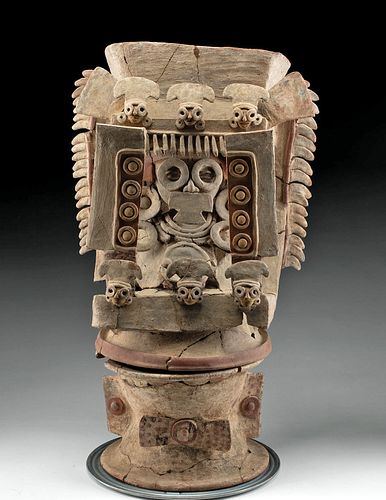Teotihuacan Pottery Incensario of Rain God Tlaloc, TL'd
About Seller
686 S Taylor Ave, Ste 106
Louisville, CO 80027
United States
Selling antiquities, ancient and ethnographic art online since 1993, Artemis Gallery specializes in Classical Antiquities (Egyptian, Greek, Roman, Near Eastern), Asian, Pre-Columbian, African / Tribal / Oceanographic art. Our extensive inventory includes pottery, stone, metal, wood, glass and textil...Read more
Two ways to bid:
- Leave a max absentee bid and the platform will bid on your behalf up to your maximum bid during the live auction.
- Bid live during the auction and your bids will be submitted real-time to the auctioneer.
Bid Increments
| Price | Bid Increment |
|---|---|
| $0 | $25 |
| $300 | $50 |
| $1,000 | $100 |
| $2,000 | $250 |
| $5,000 | $500 |
| $10,000 | $1,000 |
| $20,000 | $2,500 |
| $50,000 | $5,000 |
| $100,000 | $10,000 |
| $200,000 | $20,000 |
About Auction
Nov 10, 2022
Museum-worthy examples of classical antiquities (Egyptian, Greek, Roman, Near Eastern), Viking, Far East / Asian, Pre-Columbian, African / Tribal, Oceanic, Native American, Spanish Colonial, Nautical, Fossils, Ancient Jewelry, Fine / Visual Arts, so much more! Artemis Fine Arts info@artemisfinearts.com
- Lot Description
Pre-Columbian, Valley of Mexico, Teotihuacan, ca. 150 to 650 CE. A marvelous and massive theatre-type incensario featuring an ornately decorated lid with the upper body of Tlaloc, the rain deity who had power over fertility and agriculture. Portrayed traditionally, the god presents huge, goggle eyes and a naturalistic nose with a sizeable nasal ornament vaguely resembling the shape of the cross of Tlaloc, that extends downward to cover his mouth. He is armed with an annular shield and elaborately dressed in layered necklaces and huge, dangling earspools, as thick plumage extends from his headdress. A trio of Tlaloc heads are featured above and below, while 4 target motifs representing jade headband disks and vertical bands of plumage present on either side of the central deity. Even the base is embellished with rain glyphs. An outstanding example, replete with iconography and artistic virtuosity! Size (together): 15" W x 25.6" H (38.1 cm x 65 cm); (top only): 15" W x 18.5" H (38.1 cm x 47 cm); (bottom only): 10.4" W x 7.1" H (26.4 cm x 18 cm)
Tlaloc (Chaac to the Maya) is the Mesoamerican rain deity, who with his axe made of lightning, strikes the clouds and produces thunder and rain. In Aztec iconography, he is depicted with goggles around his eyes and large fangs. He is also frequently represented in artwork from Teotihuacan and seems to have been one of the most commonly depicted of the Mesoamerican gods.
This censer is known as a "theater type" and is among the most emblematic articles of visual culture of Teotihuacan, which then inspired contemporaries and the civilizations that came after them. These were first created in the Tzacualli period (1 to 100 CE), and during the following years, artisans created more and more intricate compositions. Molds were used to make various ornaments that were glued to the primary body and the plates were arranged in superimposed planes as we see in this example. They are known as "theater" because they seem to represent the architecture of a temple, with the mask at the center representing the deity within the temple. Numerous scholars have suggested that censers like this example were instrumental to a cult dedicated to warriors killed in combat. Incense played a major role in religious practice in Mesoamerica, from the Olmec onward. Many tombs are outfitted with incensarios and the items also seem to have been used in ceremonies by the living. The incense was made from copal, tree resin from the torchwood tree. By burning copal, Mesoamerican priests made an offering to the gods - for example, during an Aztec ceremony for the god Huitzilopochtli, the hummingbird-formed god of war, priests hoped that their prayers would be carried upward along with the wafting smoke and scent.
Provenance: ex-Marc Amiguet Schmitt estate, Amiguet's Ancient Art, Evansville, Indiana, USA, acquired prior to January 1, 2010.
This piece has been tested using thermoluminescence (TL) analysis and has been found to be ancient and of the period stated. A full printed and bound report is available to the buyer upon request.
#173339Professionally repaired and restored from several peaches with some areas of chipping and losses along visible break lines and to rim. Some infill additionally along break lines, and surface wear commensurate with age as shown. Nice pigments and remaining detail. TL holes to bottom of lid and top right feathers.Condition
- Shipping Info
-
Artemis Gallery will no longer be able to offer in-house shipping for most international orders, as well as all oversized orders, including most paintings. These items are clearly marked in the listing as “3rd Party Shipping Required” in the listing. We have a list of recommended third party shippers to assist you in shipping to and from, and would be happy to assist you in working with them. We require a written authorization from the client to release property to any third party. You may fax a Shipping Release Form to 303-828-3235 or email your authorization to kristen@artemisgallery.com. Please note the all property must be removed from our premises within seven (7) business days following the last day of the auction.
-
- Buyer's Premium



 EUR
EUR CAD
CAD AUD
AUD GBP
GBP MXN
MXN HKD
HKD CNY
CNY MYR
MYR SEK
SEK SGD
SGD CHF
CHF THB
THB
















